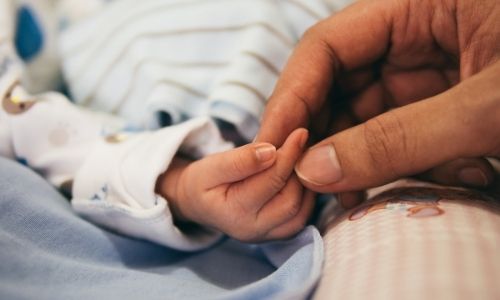Genetics of mother and baby contribute to most cases where babies are born very large or very small, according to new research.
Genetics of mother and baby contribute to most cases where babies are born very large or very small, according to new research.
A large scale study, led by the University of Exeter and Cardiff University, has found the strongest evidence to date that genetics play a major role in most cases when babies born at full term are in the top or bottom 10 per cent of the weight spectrum.
However, in the three per cent of babies with the smallest birth weights, genetics seemed to play a less important role. This indicated that other factors may be contributing to the babies’ small size. The research looked at 190 common genetic variations that are known to affect birth weight, yet it is possible that rare genetic changes in the baby reduce growth in the smallest three per cent. Other important factors could include the health of the mother or fetus or of the placenta, which transfers nutrients and oxygen to the baby.
The study was a collaboration also involving the University of Bristol’s Children of the 90s, Imperial College London, and the University of Oulu in Finland. The research was supported by Wellcome Trust and the H2020 program of the European Commission.
The weight of babies at birth is important, as those born at the extreme ends are at higher risk of complications. Smaller babies are more likely to be admitted to neonatal units and at higher risk of death, while larger babies are at higher risk of complications during birth.
To examine the extent to which birth weight was linked to the genetics of mothers and babies, the team created a genetic score for higher birth weight. Published today in PLOS Genetics, the study tested whether the genetic score was higher or lower in babies who were born very large or very small in a sample of nearly 12,000 babies and more than 5,000 mothers of European ancestry. The mothers and babies were from Children of the 90s, a health study based at the University of Bristol, the Exeter Family Study of Childhood Health and the Northern Finland Birth Cohorts 1966 and 1986.
Dr Robin Beaumont, of the University of Exeter Medical School, was lead author of the study. He said: “This research casts new light on why some babies are born very large or small. This knowledge will help both parents and clinicians understand where they need to focus medical attention. Genetics played a lesser role in the three per cent of babies with the lowest weight, suggesting that other factors such as the health of the placenta, may have influenced their weight.”
Co-lead author and clinician, Professor Sailesh Kotecha, of Cardiff University, added: “It’s important to identify reasons why babies are born with low birth weight as they are at risk of increased health problems in later life including diabetes and high blood pressure. Our work shows that genetics are a key part of the reason why some babies are born small, and raises the possibility that genetics could be used alongside maternal and placental factors to identify those most likely to have fallen short of their growth potential.”
Professor Rachel Freathy, of the University of Exeter, who oversaw of the study said: “Our study gives the greatest insight to date into how common genetic variations between people influence the extremes of birth weight. We now need to understand better whether the genetics or environmental factors are more important in the later life health risks.”
The paper is entitled ‘Common maternal and fetal genetic variants show expected polygenic effects on risk of small- or large-for-gestational-age (SGA or LGA), except in the smallest 3% of babies’, and is published in PLOS Genetics.
Further information
The paper is entitled ‘Common maternal and fetal genetic variants show expected polygenic effects on risk of small- or large-for-gestational-age (SGA or LGA), except in the smallest 3% of babies’, and is published in PLOS Genetics.
About the University of Exeter Medical School
The University of Exeter Medical School is part of the University of Exeter’s College of Medicine and Health. Our mission is to improve the health of the South West and beyond, through the development of high quality graduates and world-leading research that has international impact.
As part of a Russell Group university, we combine this world-class research with very high levels of student satisfaction. Exeter has over 19,000 students and is ranked 12th in The Times and Sunday Times Good University Guide 2020.
The University of Exeter Medical School’s Medicine course is in the top 10 in the Complete University Guide 2020.
The College’s Medical Imaging programme is ranked in the top 5 in the Guardian Guide 2020 and the Complete University Guide 2020.
The University of Exeter entered the world top 20 for Biomedical and Health Sciences in the CWTS Leiden Ranking 2019, based on the percentage of publications ranked in the top 10 per cent most cited.
Cardiff University is recognised in independent government assessments as one of Britain’s leading teaching and research universities and is a member of the Russell Group of the UK’s most research intensive universities. The 2014 Research Excellence Framework ranked the University 5th in the UK for research excellence. Among its academic staff are two Nobel Laureates, including the winner of the 2007 Nobel Prize for Medicine, Professor Sir Martin Evans. Founded by Royal Charter in 1883, today the University combines impressive modern facilities and a dynamic approach to teaching and research. The University’s breadth of expertise encompasses: the College of Arts, Humanities and Social Sciences; the College of Biomedical and Life Sciences; and the College of Physical Sciences and Engineering, along with a longstanding commitment to lifelong learning. Cardiff’s flagship Research Institutes are offering radical new approaches to pressing global problems. More at www.cardiff.ac.uk
About Children of the 90s
Based at the University of Bristol, Children of the 90s, also known as the Avon Longitudinal Study of Parents and Children (ALSPAC), is a long-term health-research project that enrolled more than 14,000 pregnant women in 1991 and 1992. It has been following the health and development of the parents and their children in detail ever since and is currently recruiting the children and the siblings of the original children into the study. It receives core funding from the Medical Research Council, the Wellcome Trust and the University of Bristol. Find out more at www.childrenofthe90s.ac.uk

